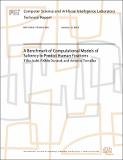| dc.contributor.advisor | Frédo Durand | |
| dc.contributor.author | Judd, Tilke | en_US |
| dc.contributor.author | Durand, Frédo | en_US |
| dc.contributor.author | Torralba, Antonio | en_US |
| dc.contributor.other | Computer Graphics | en |
| dc.date.accessioned | 2012-01-13T22:30:12Z | |
| dc.date.available | 2012-01-13T22:30:12Z | |
| dc.date.issued | 2012-01-13 | |
| dc.identifier.uri | http://hdl.handle.net/1721.1/68590 | |
| dc.description.abstract | Many computational models of visual attention have been created from a wide variety of different approaches to predict where people look in images. Each model is usually introduced by demonstrating performances on new images, and it is hard to make immediate comparisons between models. To alleviate this problem, we propose a benchmark data set containing 300 natural images with eye tracking data from 39 observers to compare model performances. We calculate the performance of 10 models at predicting ground truth fixations using three different metrics. We provide a way for people to submit new models for evaluation online. We find that the Judd et al. and Graph-based visual saliency models perform best. In general, models with blurrier maps and models that include a center bias perform well. We add and optimize a blur and center bias for each model and show improvements. We compare performances to baseline models of chance, center and human performance. We show that human performance increases with the number of humans to a limit. We analyze the similarity of different models using multidimensional scaling and explore the relationship between model performance and fixation consistency. Finally, we offer observations about how to improve saliency models in the future. | en_US |
| dc.format.extent | 22 p. | en_US |
| dc.relation.ispartofseries | MIT-CSAIL-TR-2012-001 | |
| dc.rights | Creative Commons Attribution 3.0 Unported | en |
| dc.rights.uri | http://creativecommons.org/licenses/by/3.0/ | |
| dc.subject | fixation maps, saliency maps, vision | en_US |
| dc.title | A Benchmark of Computational Models of Saliency to Predict Human Fixations | en_US |
| dc.language.rfc3066 | en-US | |

